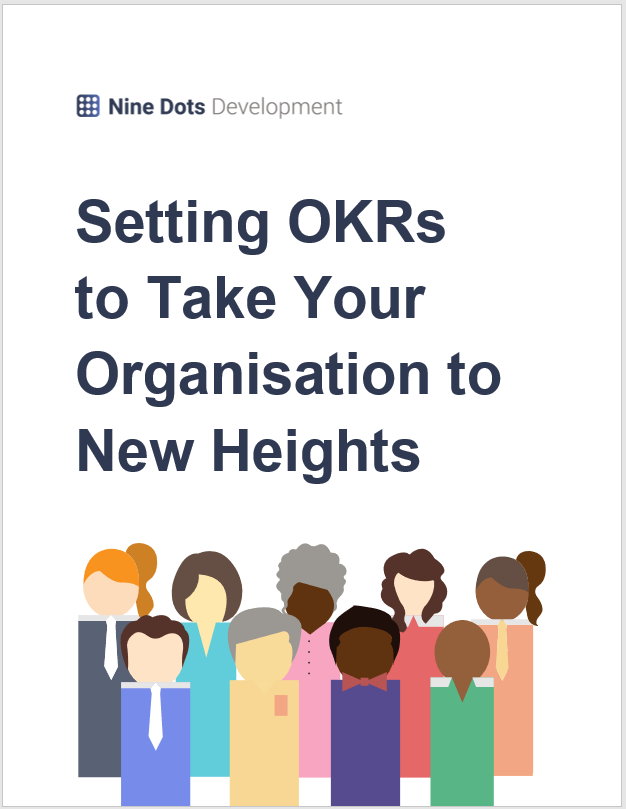Tuesday 05 Oct 2021 Article
The TakeawayA Simple Methodology for Setting Attainable Goals for Teams and Employees
Overwhelming Workloads
Part 4
#Leadership #Management #Method #Workload #Guide #OKRs #GoalSetting #PersonalDevelopment
The perfectly matched resource for this article...
Download Our Free 'Setting OKRs to Take Your Organisation to New Heights' Guide!
Please click below to download our free 'Setting OKRs to Take Your Organisation to New Heights' Guide!
Download our free guide!A Simple Methodology for Setting Attainable Goals for Teams and Employees
Leaders who are career-driven, passionate, high-achievers will naturally put pressure on their staff to work hard, and will try to get the most out of their workforce to move the department and organisation towards its goals.
However, this means that employees are sometimes given unrealistically large workloads, leading to a whole host of potential problems.
In today’s article, we explore the consequences of giving staff overwhelming workloads, how to use a combination of a top-down and a bottom-up approach to push staff to their capacity but not past it, and we give you a goal-setting methodology that you or your leaders can use to set ambitious but attainable goals for their teams and employees.
The Consequences of Overwhelming Workloads
Whilst leaders who push their staff to their limits are usually just trying to push their staff to their full potential because they have high hopes and expectations for them, it’s important to balance these expectations and goals with solid strategies to prevent employees from becoming overwhelmed and overworked.
Overworking staff can have many undesirable consequences, including:
- Decreased motivation
When staff are constantly leaving work without finishing everything that they’d planned to do because the workload is unrealistic, it can be extremely disheartening and unmotivating. - Delayed projects
When leaders expect staff to finish tasks by a certain deadline but they don’t because of their unmanageable workload, it can derail projects from the plan and delay them. - Quality deteriorates
Some staff have overwhelming workloads but manage to complete all of their work - the issue here is that in order to do the tasks quickly, staff often put less of a focus on quality and doing tasks properly. - Development isn’t a priority
With staff barely having enough time to complete their day-to-day tasks, career development quickly grinds to a halt, meaning that employees learn and progress in their career much slower. - Employees burn out
If this goes on for a longer period of time, staff can burn out and may need time off work, which is why overworking staff is so counterproductive.
{{ADVERT}}
Why Combining a Bottom-up and a Top-down Approach is Key to Goal-setting
Preventing staff from becoming overwhelmed is all about leaders and employees both knowing their limits.
Goals and objectives are typically set top-down, with the overarching goal being set by senior leadership and then being broken down into each department. Leaders need to be aware of their own limits and capacity, otherwise they may take on too much work and end up having to delegate too much to their teams, running the risk of overworking their staff; if leaders are overworked, more often than not their staff are too. On the other hand, if leaders have a good attitude to workload and know their own limits, their staff will likely follow suit.
These departmental goals are then broken down into team and individual goals, so taking a bottom-up approach where leaders allow staff autonomy on deciding how they will meet these goals can be extremely beneficial, putting staff in the driving seat of determining their day-to-day workload. However, leaders may not realise everything their staff already have on their plate and may therefore assume that staff have more time than they actually do, so setting goals requires honesty and transparency from staff, as well as the confidence to say ‘no’ to requests if they’re already at full capacity.

The risk with using a bottom-up approach is that staff may underestimate their capacity and limits, especially if they struggle with confidence, and say ‘no’ to too many things. To combat this, teams can use time allocation and planning to determine where their time is going and how much time they have spare to spend on new requests, initiatives, or projects. We explored this and many other aspects of using time effectively in our ‘Struggling with Time Management?’ article series which you can click here to read.
A Simple Methodology for Setting Attainable, Realistic Goals
Preventing workloads from getting overwhelming is much more effective than trying to resolve them, so it’s crucial to have a strong, tried and tested, goal-setting methodology in place.
A goal-setting methodology that we’ve recommended time and time again, written about in a previous article, and personally use here at Nine Dots, is OKRs.
OKRs are broken down into two parts; Objectives and Key Results.
- Objectives are “what is to be achieved; no more, no less”. They should be “significant, concrete action-orientated and ideally inspirational”. Each objective should then have 2-5 Key Results.
- Key Results “benchmark and monitor how we get to the objective”. They should be “specific, time-bound, measurable and verifiable”.
Put simply, the Objective is what we want to achieve and the Key Results are how we plan to achieve it.
OKRs are a collaborative goal-setting methodology, meaning that leaders should work closely together with their staff to create their OKRs. This gives staff the opportunity to speak up if they think the workload would be too much, helping keep goals attainable and realistic.
To help you get started, you can click here to download our guide to ‘Setting OKRs to Take Your Organisation to New Heights’.
---
Until next time...
Download Our Free 'Setting OKRs to Take Your Organisation to New Heights' Guide!
Please click below to download our free 'Setting OKRs to Take Your Organisation to New Heights' Guide!
Download our free guide!Missed an article?
More from Overwhelming Workloads
